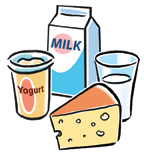Lactose is a simple sugar found in milk and other dairy products. It's found in dairy products such as milk, soft and processed cheese, cottage cheese, cream, and sour cream. It's also found in ice cream, sherbet, milk solids, powdered milk, and whey.
Your body digests lactose with the help of an enzyme the body makes called lactase. Lactase works in the small intestine. People with lactose intolerance can't digest dairy products. This is because their bodies don't make enough lactase. Undigested lactose passes into your large intestine (colon) where it can't be absorbed. The bacteria in your colon break down this undigested lactose. This produces fluid and gas that cause lactose intolerance symptoms. These may include nausea, cramping, bloating, gas, diarrhea, stomach “growling” or rumbling sounds, and foul-smelling stools. The symptoms occur within 30 minutes to 2 hours after eating. How bad the symptoms are depends on the amount of foods with lactose that you eat, how much lactase your body makes, and how long it takes for food to move through your small intestine.
Less commonly, lactose intolerance can cause headaches, muscle pain, joint pain, mouth ulcers, urinary problems, and problems concentrating.
Babies are born with the lactose enzyme, which allows them to absorb breast milk. But lactose intolerance may appear in children as early as 2 to 5 years old. It is most often seen in teens and young adults. Even if you've been able to eat dairy products all your life, your body may be unable to make the lactose enzyme as you get older. Asians, African Americans, Hispanics, and American Indians tend to get this problem earlier in life.
Lactose intolerance is not the same as a milk allergy. A milk allergy is an immune system disorder that can cause death.
Home care
These guidelines will help you care for yourself at home:
-
Your body doesn’t need dairy products to be healthy. So if your symptoms are severe, it's best to stop eating dairy products that contain lactose.
-
If your symptoms are milder, you can probably eat or drink smaller amounts of dairy as long as you have it with nondairy foods. Yogurt with live cultures may be okay because it contains enzymes that digest lactose. Butter and hard and aged cheeses (like cheddar and Swiss) contain less lactose and may be okay to eat. Greek yogurt has the least amounts of lactose. You will have to experiment to learn how much dairy you can have without getting symptoms. It may help to keep a food diary.
-
There are many lactose-free or low-lactose dairy products, including milk, ice cream, and cheeses. They allow you to still enjoy dairy products. You may also take a lactase enzyme as a supplement that will help you digest dairy products. Probiotics may also help improve symptoms. But check with your health care provider before starting them.
-
Everyone needs calcium and vitamin D in their diet for healthy bones. If you reduce or cut dairy from your diet, you need to replace it with other foods that contain these nutrients. These foods include kale, broccoli, white beans, green beans, lima beans, salmon, soybeans, tofu, almonds, Brazil nuts, and dried beans. Some foods, such as cereals, soy milk, and fruit juices, have calcium and vitamin D added. Talk with your provider about the best way for you to get the calcium and vitamin D your body needs.
-
Learn to read food labels. Also watch for prepared foods that are made with products that contain lactose. These include bread, cereal, lunch meats, salad dressings, cake and cookie mix, and coffee creamers. Many people can have small amounts of lactose without symptoms. So an overly strict diet is often not needed.
-
Lactase enzyme supplements can be bought at a drugstore without a prescription. They can help control symptoms if you take the enzymes when you eat lactose.
Other products besides milk and milk products may contain lactose. They may be less obvious, so check the labels carefully. These things may not bother you, but foods to think about if you continue to have problems include:
-
Bread and other baked goods.
-
Waffles, pancakes, biscuits, cookies, and mixes to make them.
-
Processed breakfast foods, such as doughnuts, frozen waffles and pancakes, toaster pastries, and sweet rolls.
-
Processed breakfast cereals.
-
Instant potatoes, soups, and breakfast drinks.
-
Potato chips, corn chips, and other processed snacks.
-
Processed meats like bacon, sausage, hot dogs, and lunch meats.
-
Margarine.
-
Salad dressings.
-
Liquid and powdered milk-based meal replacements.
-
Protein powders and bars.
-
Candies.
-
Nondairy liquid and powdered coffee creamers.
-
Nondairy whipped toppings.
Follow-up care
Follow up with your health care provider, or as advised. Talk with a registered dietitian about making your own meal plan to manage your symptoms while making sure that you get enough nutrients.
When to get medical advice
Call your health care provider right away if you have:
-
Increasing belly (abdominal) pain or swelling.
-
Abdominal pain that moves to the right side of the lower abdomen.
-
A fever of 100.4ºF (38ºC) or higher, or as advised by your provider.
-
Repeated vomiting or diarrhea.
Seek medical care immediately if there is blood in your stool or your stool looks black and tarry.
Call 911 if you feel weak or dizzy or like you might faint.


